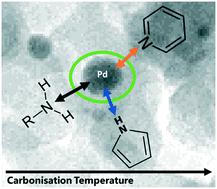当前位置:
X-MOL 学术
›
Catal. Sci. Technol.
›
论文详情
Our official English website, www.x-mol.net, welcomes your
feedback! (Note: you will need to create a separate account there.)
Directing nitrogen-doped carbon support chemistry for improved aqueous phase hydrogenation catalysis
Catalysis Science & Technology ( IF 4.4 ) Pub Date : 2020-07-01 , DOI: 10.1039/d0cy00391c Monika Bosilj 1, 2, 3, 4, 5 , Lina Rustam 1, 2, 3 , Ralf Thomann 3, 5, 6, 7 , Julia Melke 3, 4, 5, 6, 7 , Anna Fischer 3, 4, 5, 6, 7 , Robin J. White 1, 2, 3, 8, 9
Catalysis Science & Technology ( IF 4.4 ) Pub Date : 2020-07-01 , DOI: 10.1039/d0cy00391c Monika Bosilj 1, 2, 3, 4, 5 , Lina Rustam 1, 2, 3 , Ralf Thomann 3, 5, 6, 7 , Julia Melke 3, 4, 5, 6, 7 , Anna Fischer 3, 4, 5, 6, 7 , Robin J. White 1, 2, 3, 8, 9
Affiliation

|
Selective hydrogenations in the aqueous phase are an important transformation in the context of developing biorefinery concepts. In this report the application and optimisation of nitrogen-doped carbon (NDC) supported Pd nanoparticles as hydrogenation catalysts is discussed in the context of directing support (e.g. N) chemistry for improved catalytic performance in the aqueous phase. As a demonstrative example, the aqueous phase hydrogenation of phenol to cyclohexanone (e.g. a platform for polyamide production) is utilised. Catalyst supports were prepared based on an initial hydrothermal synthesis to yield NDC xerogels (from biomass precursors), the chemistry of which (e.g. functionality) was directed using a secondary thermal carbonisation (Tc) step at different temperatures (i.e. 350, 550, 750, 900 and 1000 °C). After Pd introduction, it was found that size, dispersion and electronic structure of the formed nanoparticles is affected by the surface chemistry of the NDC. This consequently led to higher turn-over frequency (TOF) and stability of the prepared catalysts compared to a “nitrogen-free” carbon supported Pd and a commercial, carbon supported Pd (Pd/AC) catalyst. Pd/NDC 900 (featuring predominantly quaternary and pyridinic N) catalysed the complete conversion of phenol at 99% selectivity to cyclohexanone, with excellent stability over 11 recycles and no discernible catalyst sintering or leaching (in contrast to the commercial catalyst). High catalytic stability, activity and selectivity make the Pd/NDC 900 catalyst highly applicable for aqueous phase hydrogenation reactions, whilst the general principle opens scope for support tailoring for application (e.g. biorefinery hydrogenations) and the development of structure/activity relationships.
中文翻译:

指导氮掺杂碳载体化学反应以改善水相加氢催化
在发展生物精炼概念的背景下,水相中的选择性氢化是重要的转变。在该报告中,在指导载体(例如N)化学以改善水相催化性能的背景下,讨论了氮掺杂碳(NDC)负载的Pd纳米颗粒作为氢化催化剂的应用和优化。作为说明性实例,利用苯酚的水相氢化成环己酮(例如,用于聚酰胺生产的平台)。基于初始水热合成制备催化剂载体,以生产NDC干凝胶(由生物质前体产生),其化学性质(例如功能性)通过二次热碳化(Tc)在不同温度下步进(即350、550、750、900和1000°C)。引入Pd后,发现形成的纳米颗粒的尺寸,分散性和电子结构受NDC的表面化学影响。因此,与“无氮”碳载Pd和市售碳载Pd(Pd / AC)催化剂相比,这导致了制备的催化剂具有更高的周转频率(TOF)和稳定性。Pd / NDC 900(主要是季铵和吡啶鎓N)催化苯酚以99%的选择性完全转化为环己酮,在11个循环中具有出色的稳定性,并且没有明显的催化剂烧结或浸出(与市售催化剂相比)。高催化稳定性,活性和选择性使Pd / NDC 900催化剂高度适用于水相加氢反应,例如生物炼油厂的氢化)和结构/活性关系的发展。
更新日期:2020-07-21
中文翻译:

指导氮掺杂碳载体化学反应以改善水相加氢催化
在发展生物精炼概念的背景下,水相中的选择性氢化是重要的转变。在该报告中,在指导载体(例如N)化学以改善水相催化性能的背景下,讨论了氮掺杂碳(NDC)负载的Pd纳米颗粒作为氢化催化剂的应用和优化。作为说明性实例,利用苯酚的水相氢化成环己酮(例如,用于聚酰胺生产的平台)。基于初始水热合成制备催化剂载体,以生产NDC干凝胶(由生物质前体产生),其化学性质(例如功能性)通过二次热碳化(Tc)在不同温度下步进(即350、550、750、900和1000°C)。引入Pd后,发现形成的纳米颗粒的尺寸,分散性和电子结构受NDC的表面化学影响。因此,与“无氮”碳载Pd和市售碳载Pd(Pd / AC)催化剂相比,这导致了制备的催化剂具有更高的周转频率(TOF)和稳定性。Pd / NDC 900(主要是季铵和吡啶鎓N)催化苯酚以99%的选择性完全转化为环己酮,在11个循环中具有出色的稳定性,并且没有明显的催化剂烧结或浸出(与市售催化剂相比)。高催化稳定性,活性和选择性使Pd / NDC 900催化剂高度适用于水相加氢反应,例如生物炼油厂的氢化)和结构/活性关系的发展。











































 京公网安备 11010802027423号
京公网安备 11010802027423号